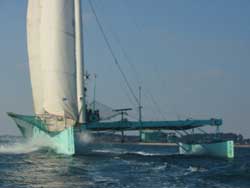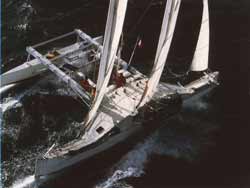


 |

|
 |
The tillers
They are balanced, swiveling up to 270 degrees, and retractables in an
ellipse
well for beaching. The bottom of the rudders are in low density foam,
to
reduce the damages when scraping the bottom with them.
2 elliptical pieces are on the rudder locks, to guide the movement of the rudders in their wells. The upper piece stay fixed on the bridge, and maintain the rudder lock which moves vertically. The lower piece travels with the rudder during its movement, and places itself automatically at the bottom of the main hull.
On each pieces, 2 rings are necessary, to allow the rotation of the rudder. The first one, in polyamide, takes the shape of the rudder stock. The second one, in stainless steel, surround the first one, so as to have stainless steel rotating upon polyamide.
The wells are elliptical, with a area for the passage of the rings. A small hoist is necessary, and goes through the upper elliptical piece, goes down to the lower elliptical piece, so as to hoist the rudder.
Advantages of the system:
- Internal system, protected from vawes and schocks.
- It can be dismantled from the bridge, without going in the water.
- Low obstruction of the bridge. Rudder raised, only the rudder stock
appears above the bridge, up to 1.10 meters high.
Beams
They
are shrouded by a diamond, like a mast, to limit their slackness (just like masts).
The lower shroud (diameter 12 millimeters) limit the load when
the float is in the water, while the upper shroud (diameter 8 millimeters)
limit the load when the float is outside water.
Float binding
A welded
tubular assembly, in galvanized steel, with electrostatic paint, links the
beams to the float. Some axles in stainless stell (diameter 27
millimeters), alvaged from a scrap metal yard (old industrial washing
machines with polyamide rings), llow a rotation of the float from front
towards the back.
Indeed, when the float's stem hits a vawe, the float can go back 2 or 3 centimeters (about one inch) on a longitudinal axle. This play is limited by sling knots tied on turnbukle.
Advantages: flexibility of the whole, limit the torsion of the beams in a
big waves' sea.
The cross-section of the float is V-shaped, to prevent loading the
beams when the float falls down brutaly onto the water (it goes down into the
water much more than a flat bottomed float).
This modfifies little the performances of the proa, because the float is counter-balanced. The drag is slightly increased.
Self-draining airlocks
2 doors allow to access the inside of the proa. A vawe can enter the airlock
when the first sliding door is open (some evacuation holes are foreseen in
this case) or when a vawe hit the floor (the automobile inner tubes flex, and
so limit the water intake).
Bridgedeck
Tillers must
be dismantled when tacking, because they are 1.90 meters long (slightly more
than 6 feet long), and would touch the masts during the
rotation. A very short tiller serves for quick tacking, in cramped areas.
Transmission is done by rope on pie slices, easily accessible and repairable
in case of trouble.
The inflatable,
with a 25 HP outboard, is used to propel the proa during docking manoeuvring.It
is connected to the back side of the main hull when
pushing.
A pad eye on the planking, upwind to the main hull, blocks the inflatable front,
while the back of the inflatable is tied on the main sail
rail, with the rope going back to a cleat. Under way, the inflatable goes up
under the net, under the wind, by a system of clutch jammer cam-cleats
positioned near winches.
chain plate
Aboard "Des Jours Meilleurs",
most of the fittings are in unidirectional
glass-fiber, epoxied. They are lighter and as strong as stainless steel
fittings.
Navigation center
It is a single
unit housing a speedometer, a sounder, an anemometer. It pivots 180 degrees,
when shunting, so as to be visible from the other rudder
seat.
Electric windlass winch
Very useful
for navigating with one's family, because anchoring operations are
tricky, physically hard, and dangerous because of the size and drag of the
proa, multiplied by the surface area of the masts. Once the anchor has set,
2
crow's-feet are used to stabilise the proa, with a harder pull than the one
of
the main hull, to compensate for the assymetry of the boat.
Masts
The masts
are glued at the intersection of 2 bulkheads of the main hull. The proa cannot
dismast. The glueing plane share the compression load, while unidirectional fiber-glass
rings, epoxied, share the tear load.A ring holds the bottom
part of the mast, its stratification coming back, spreading, under the floor
of the wing.
Another ring holds
the upper part of the mast, its stratification coming back, spreading, on
the bridge of the binnacle (dog-house ?). The trailing edge of
the mast is swiveled under the wind, so as to allow the rotation of the sail,
in accordance with the concept of the Pacific Proa.
Hooks and mast heads
Sails
are hooked at the top of the mast under way. The tension is so big that classical
halyards were slackening all the time before hooks were installed.
A
cylinder is crimped under a pressure of 30 tons on the halyards (previous
crimpings were sliding at 25 tons). On the halyards, we have a cable-textile
splice with 4 cylinders crimped corresponding to the reefing of the main sails
when the wind increases:
- Force 1: MS up
- Force 2: MS with 1 reef
- Force 3: MS with 2 reefs
- Force 4: MS with 3 reefs
This system works
perfectly. I never had any problem reefing the sails. The halyards are external
to the masts. To reef, you just release the tension at
the luff, you pull the halyard towards the bottom, then you move it to
windward (unhooking it), and the main sail goes down immediately.
Conclusion
"Des Jours Meilleurs" is
a very evolutionary boat, compared to her size and
her small weight. Manoeuvers under sails are easy, compared to the big
dimensions of the proa. Shunting at 2 people is done in less than one minute
with the 2 main sails.
Performance wise, we pushed her at more than 26 knots, with a wind around 22 knots. Cruising averages are often 10 knots. We, four adults, lived during 3 months aboard. For week-end navigations, it is possible to accomodate 8 people. The wardroom is removable, and can transform itself easily in bunks.
The proa is unsinkable, and approved in (French) first category to sail.